Gastrointestinal Physiology
1/20
Earn XP
Description and Tags
go back over 9, 11, 18
Name | Mastery | Learn | Test | Matching | Spaced |
|---|
No study sessions yet.
21 Terms
How is amylopectin broken down by amylase
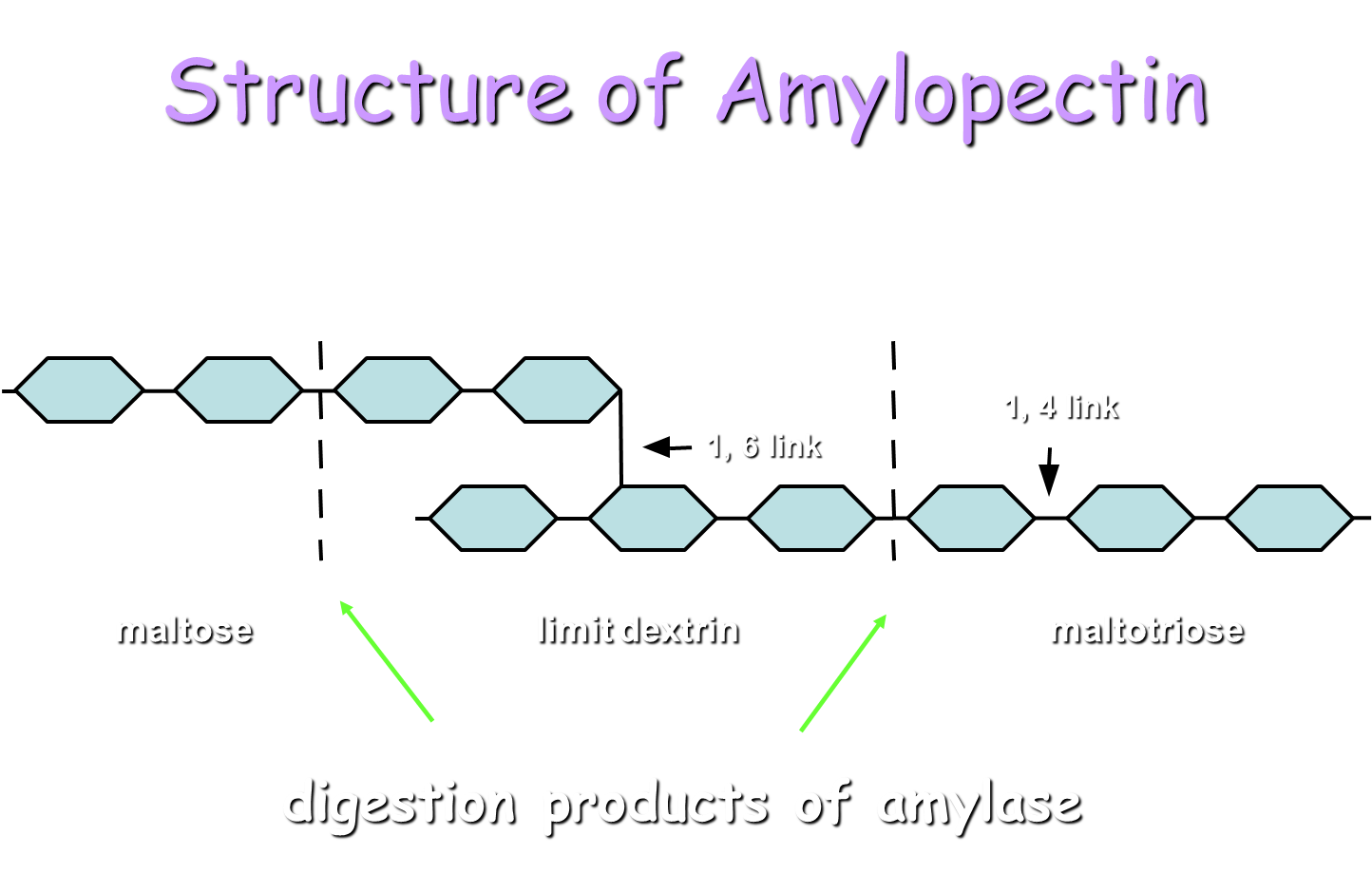
Most of the carbohydrates we intake are in the form of starch which is comprised of amylopectin, which is a bunch of branching glucose units
1) Amylase
→ salivary glands secrete amylase which will break the 1, 4 linkages between the repeating glucose linkages but will not cut the branch points, next to a branch point or at the end of a chain
→ this will break down the starch into disaccharides
What are the six disaccharides
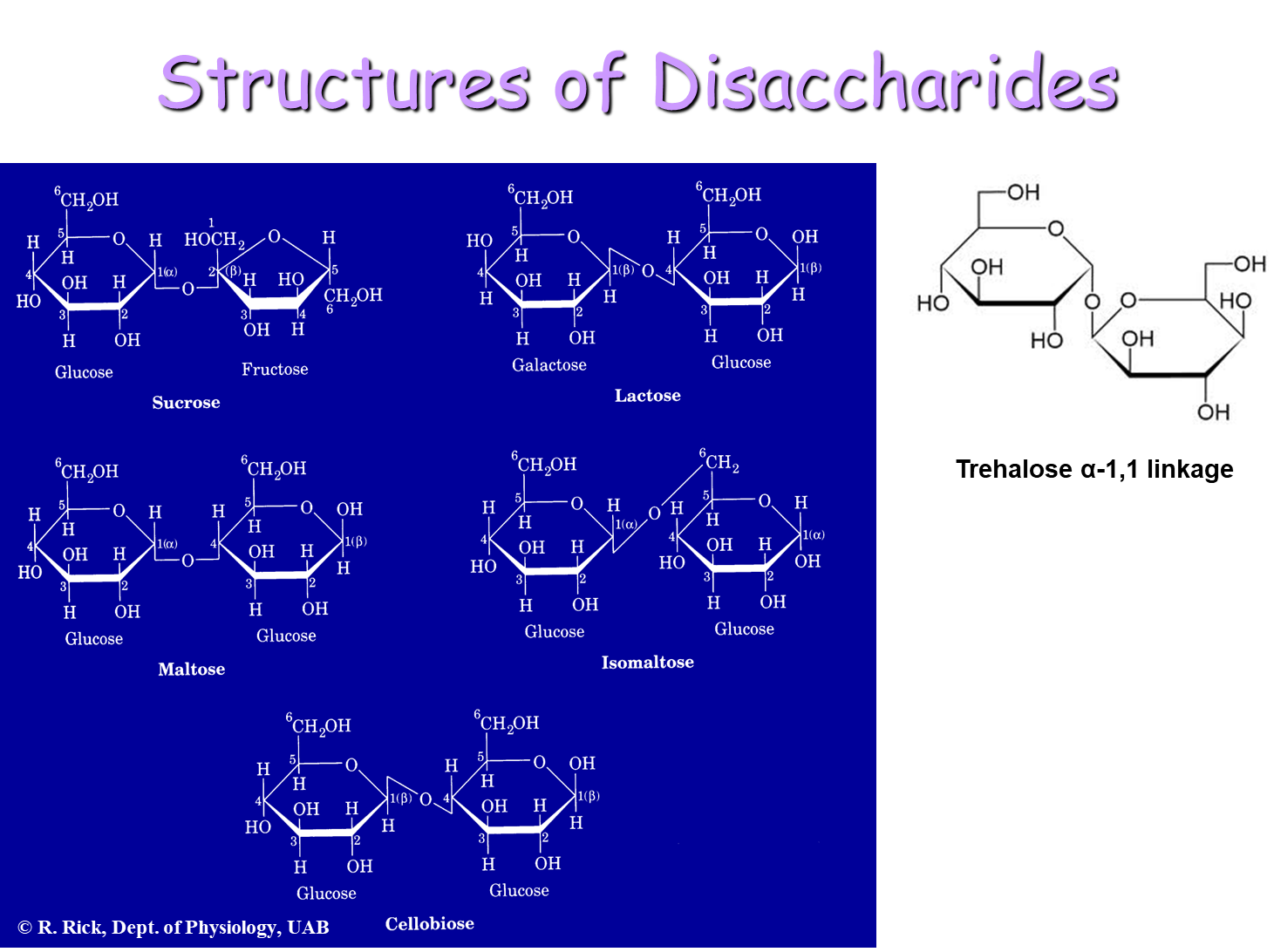
1) Sucrose
→ Glucose + Fructose
2) Lactose
→ Galactose + Glucose
3) Maltose
→ Glucose + Glucose
4) Isomaltose
→ Glucose + Glucose
5) Cellobiose
→ Glucose + Glucose
6) Trehalose
How are disaccharides digested (what are the enzymes for each)
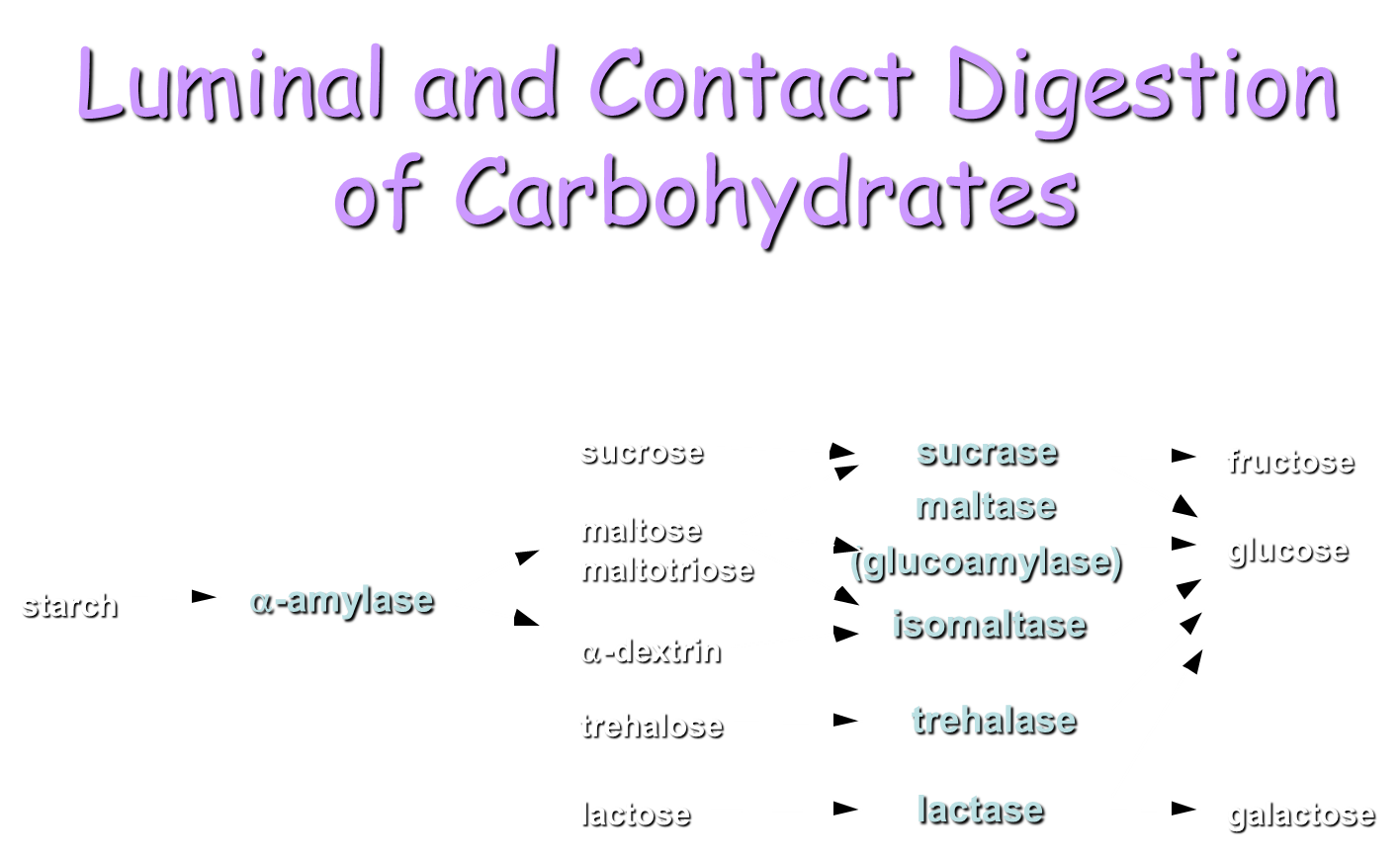
Digestion of disaccharides occurs at the brush border of the intestinal wall
→ Sucrose can be broken down by sucrase
→ Maltose can be broken down by sucrase and maltase
→ Lactose can be broken down by lactase
These enzymes are only found in the microvilli or the brush border of the enterocytes
How is glucose transported at the brush border
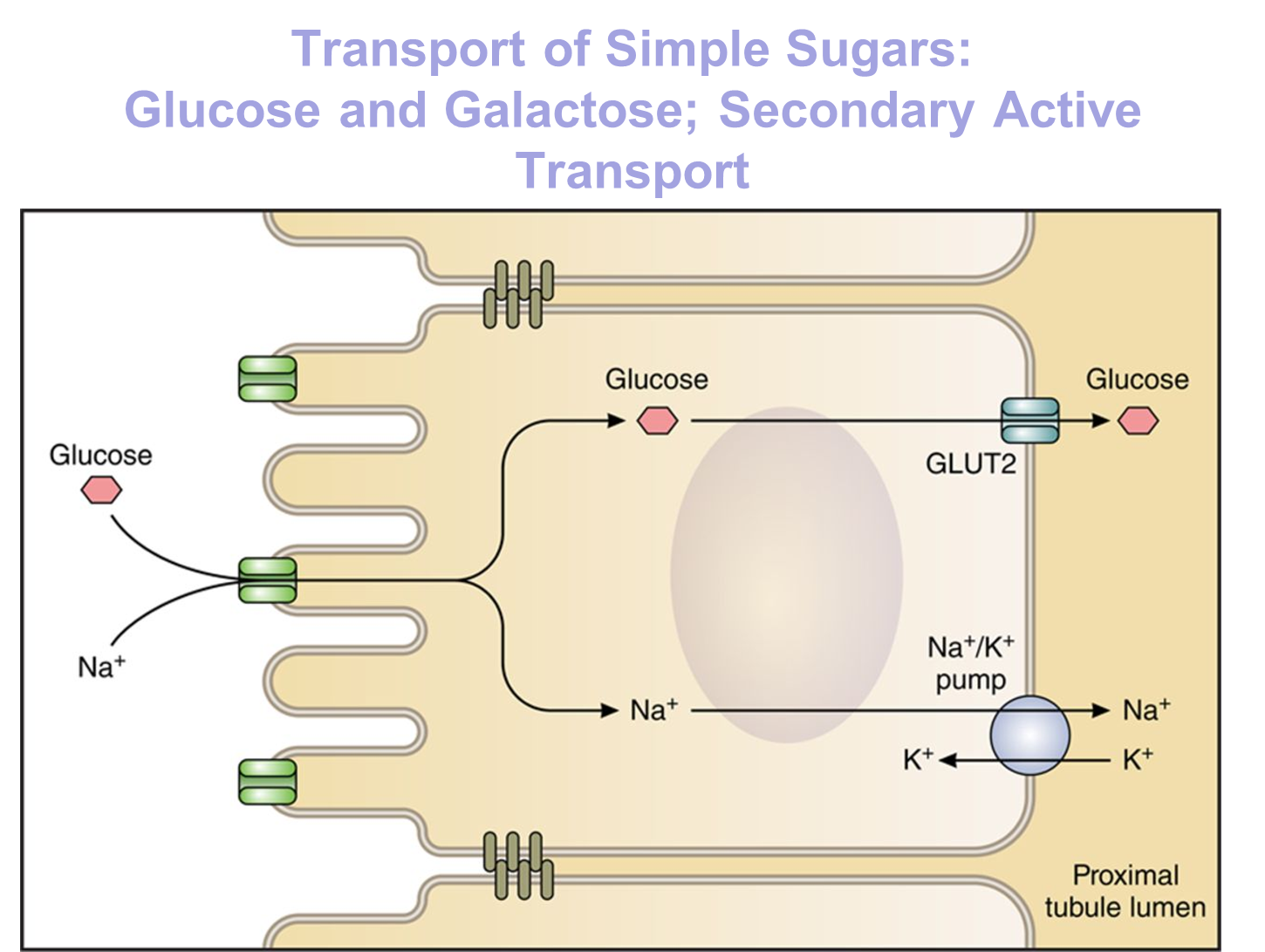
Enterocytes have a large amount of glucose inside the cell, so they need to have different transportation than the GLUT channel
1) SGLT1 Sodium-Glucose Transporter - secondary active transport
→ transports glucose and sodium together into the cell
→ done via the low sodium concentration intracellularly
2) Sodium/Potassium Pump at the basolateral side will consistently pump sodium out of the cell at the basolateral end in order to maintain a low sodium concentration
3) Glucose is then pumped out of the cell via the GLUT2 transporter via passive transport
How is fructose transported into cells?
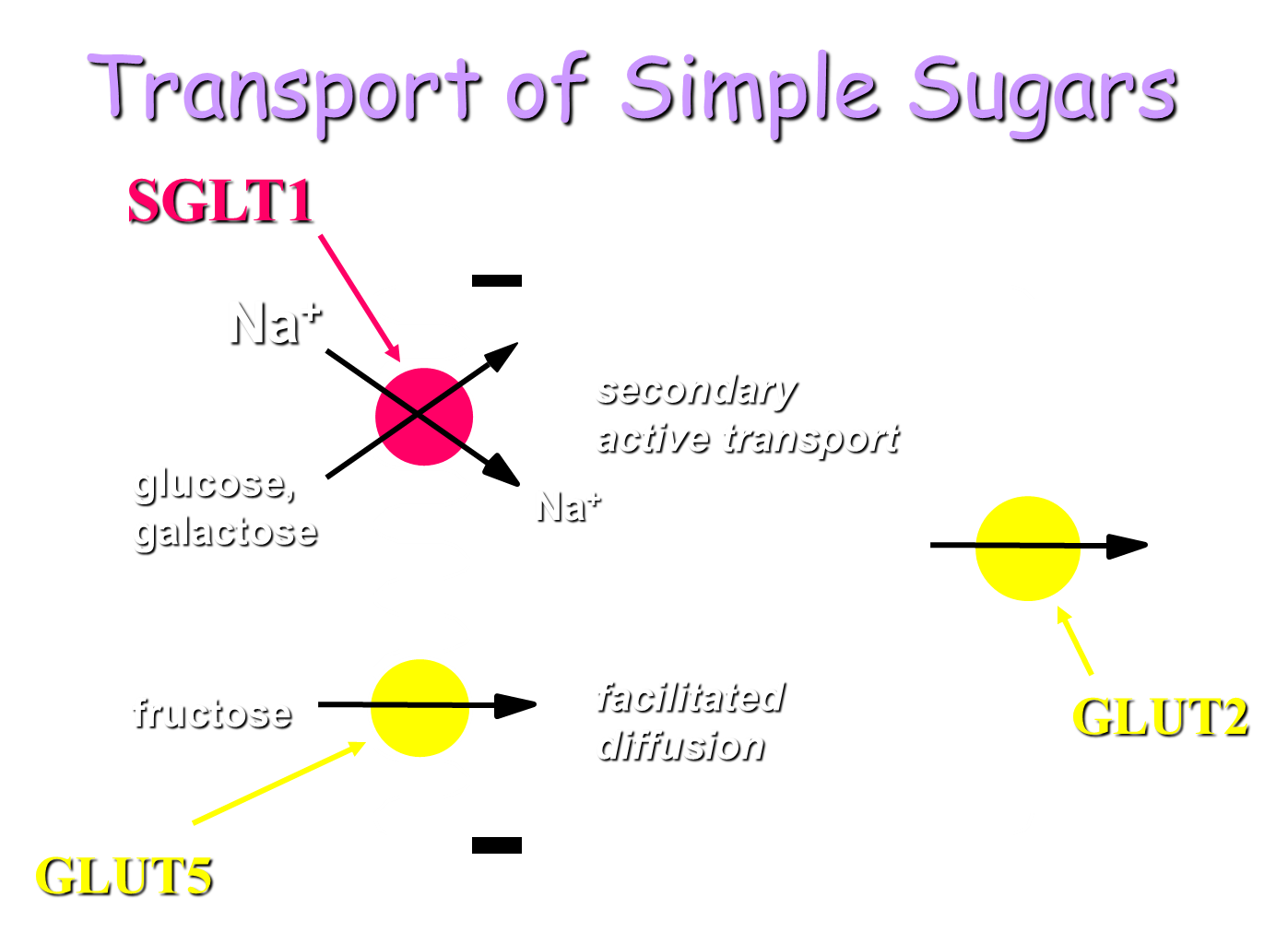
Fructose is kept at lower concentrations within the enterocyte so it can passively enter the cell via GLUT5
→ fructose will exit the cell at GLUT2 via passive transport
This is different from glucose entering the enterocyte, which requires secondary active transport via SGLT1
How does digestion of proteins work from the start to the end of the digestive system?
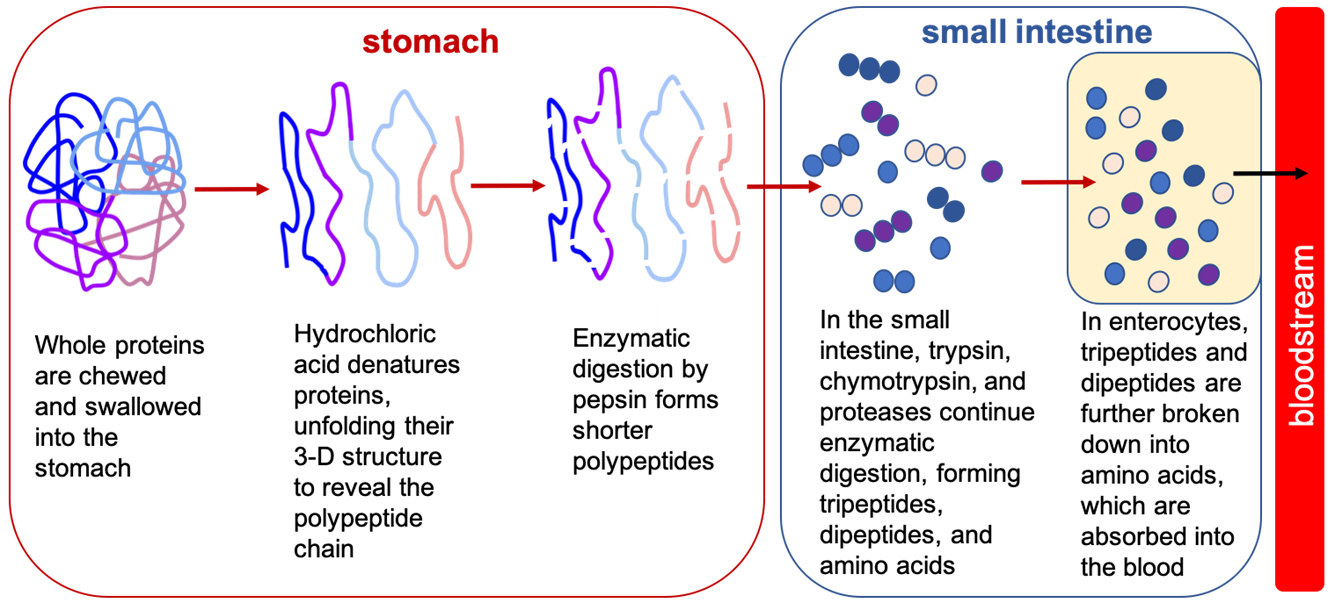
1) The initial part of digestion occurs in the mouth, where proteins are chewed up and swallowed
→ in the stomach, HCl will denature proteins and reveal their polypeptide chains
→ enzymatic digestion via pepsin will make shorter polypeptides
2) In the small intestine several proteases continue digestion
→ enterocytes take up these amino acids and are further broken down before being absorbed in the blood
What is the zymogen activation pathway for proteases?

1) Pepsinogen - activated by HCl which will be converted to pepsin
2) Trypsinogen - activated by enterokinase which is bound to the brush border
→ Trypsinogen will become trypsin which will be responsible for activating the other proteases found in the small intestine
What is the difference between endopeptidase and exopeptidases?
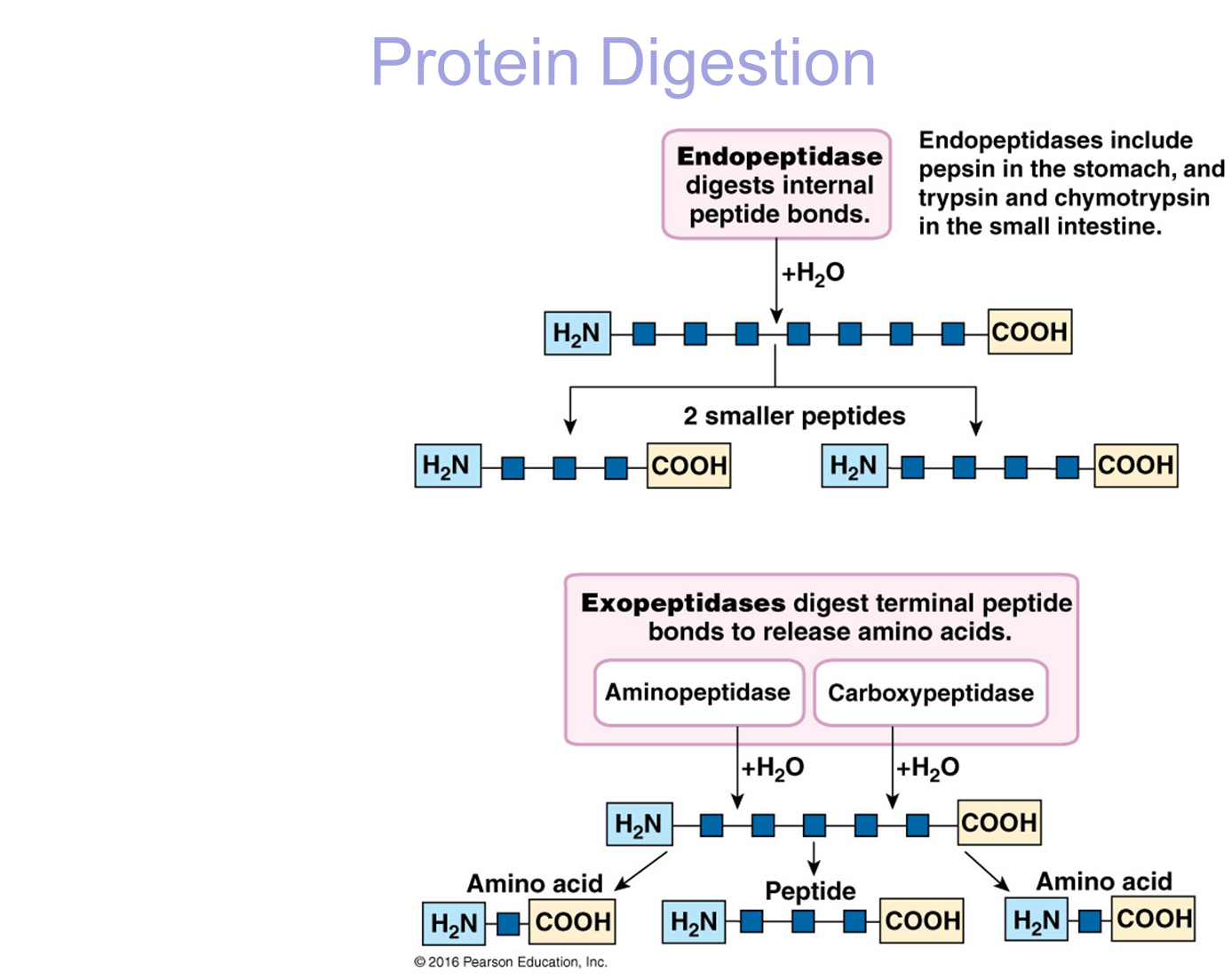
Endopeptidases
→ digest internal peptide bonds
→ include pepsin, trypsin, chymotrypsin, and elastase
Exopeptidases are enzymes that digest terminal peptide bonds to release free amino acids. There are two kinds:
→ Aminopeptidases - cleave at the amine end
→ Carboxypeptidase - cleave at the carboxyl end
How does Peptide Transport work in the Small Intestine?
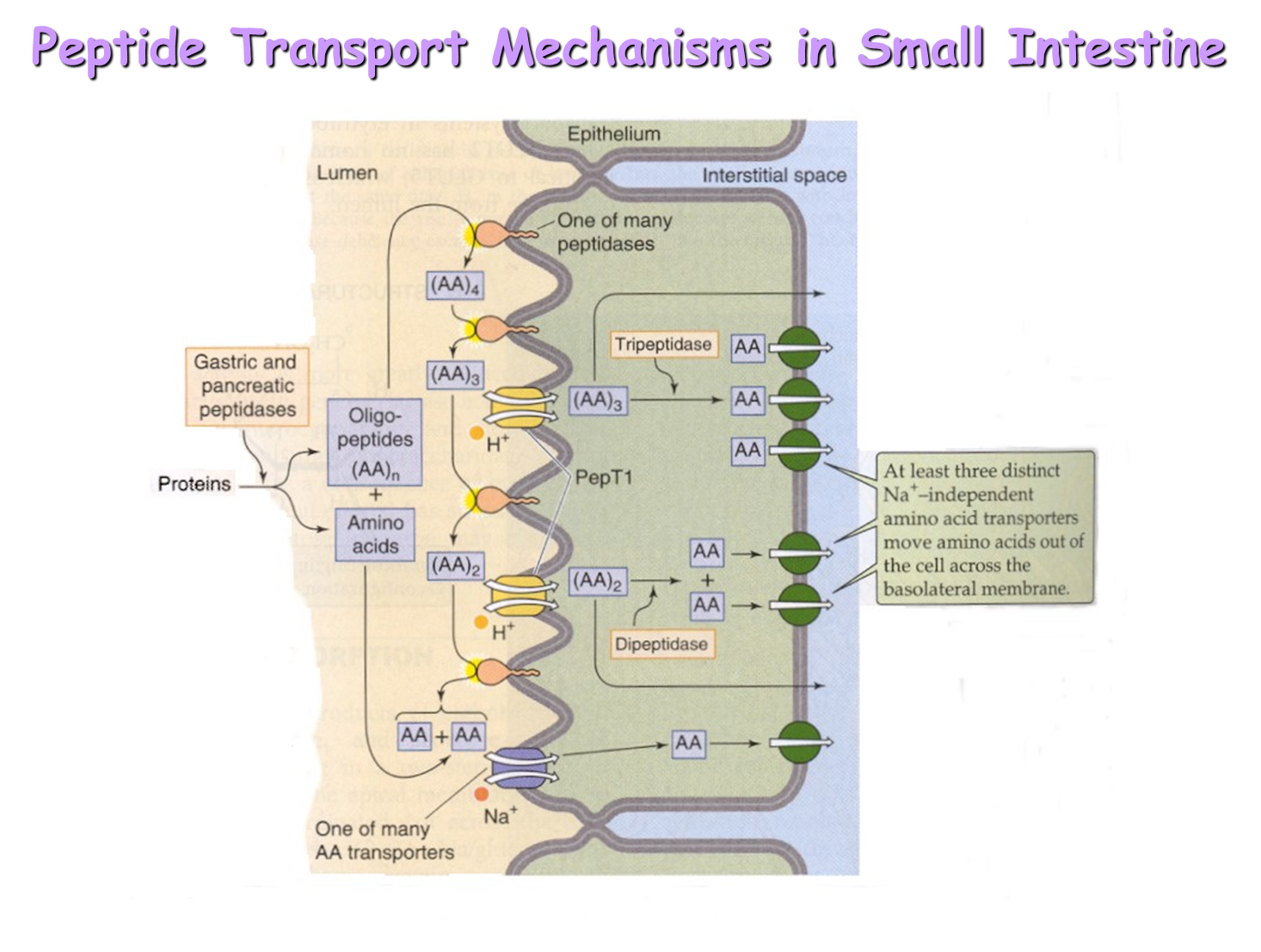
Following digestion of proteins into amino acids it will interact with the enterocytes at the small intestine
1) Secondary active transport via Amino Acid Transporters occurs and is a method for absorbing amino acids by taking use of the movement of sodium into the cell
2) PEPT1 is the main amino acid transporter that takes in oligopeptides
→ PEPT1 takes advantage of the sodium-proton exchanger which moves sodium into the enterocyte for a hydrogen out, causing acidification of the apical membrane of the enterocyte
→ this acidification of the apical membrane will allow for oligopeptides to enter via the PEPT1 transporter by using hydrogen as a secondary active transport method
3) dipeptidase and tripeptidase will further break down proteins into single amino acids
→ there is then facilitated diffusion of amino acids across the basolateral membrane into the blood
How does absorption of intact proteins occur?
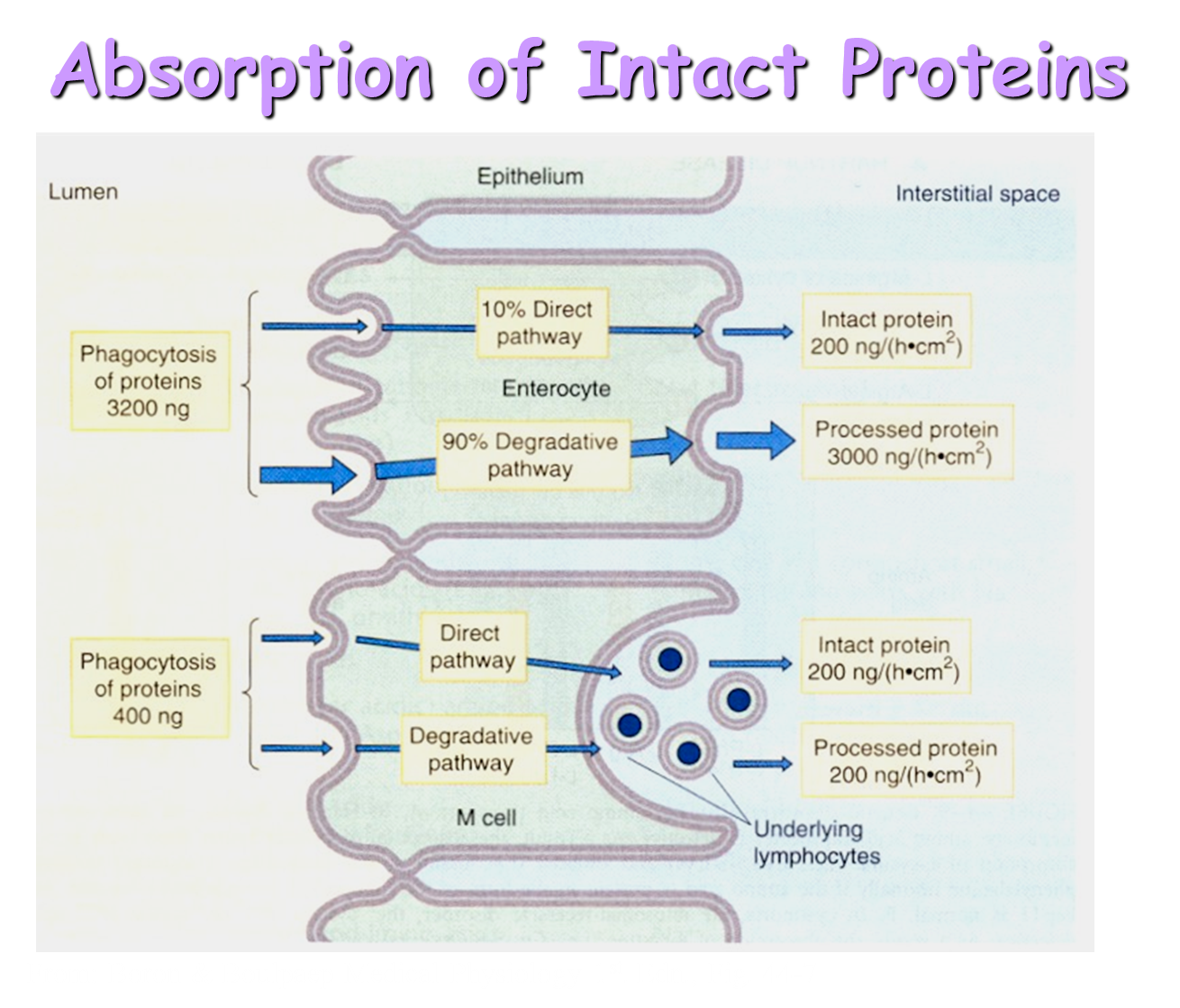
1) Some proteins are phagocytosed at the enterocyte
2) Some proteins are taken up by enterocytes by M-cells which are used in MALT function
What is the Kinetic Advantage of Peptide Absorption?

By taking in oligopeptides you we be gaining three amino acids instead of one
→ so it is kinetically advantageous to bring in oligopeptides as opposed to single amino acids
Oligopeptides can be taken up by the PepT1 transporter
What are the four stages of fat digestion
1) emulsification of fat (triglyceride, phospholipids, and cholesterol)
2) action of lipase and the incorporation of fats into micelles
3) absorption of fatty acids and monoglycerides by the enterocytes
4) uptake of chylomicrons into lacteals
What are the three major types of fatty acids?
1) Short Chain - less than 8 carbons
→ mostly synthesized by colonic gut flora as a result of fermentation of carbohydrates
2) Medium Chain - 8-14 carbons
→ absorbed readily and digested easily
3) Long Chain > 14 carbons
What is Emulsification (mouth, stomach, duodenum)
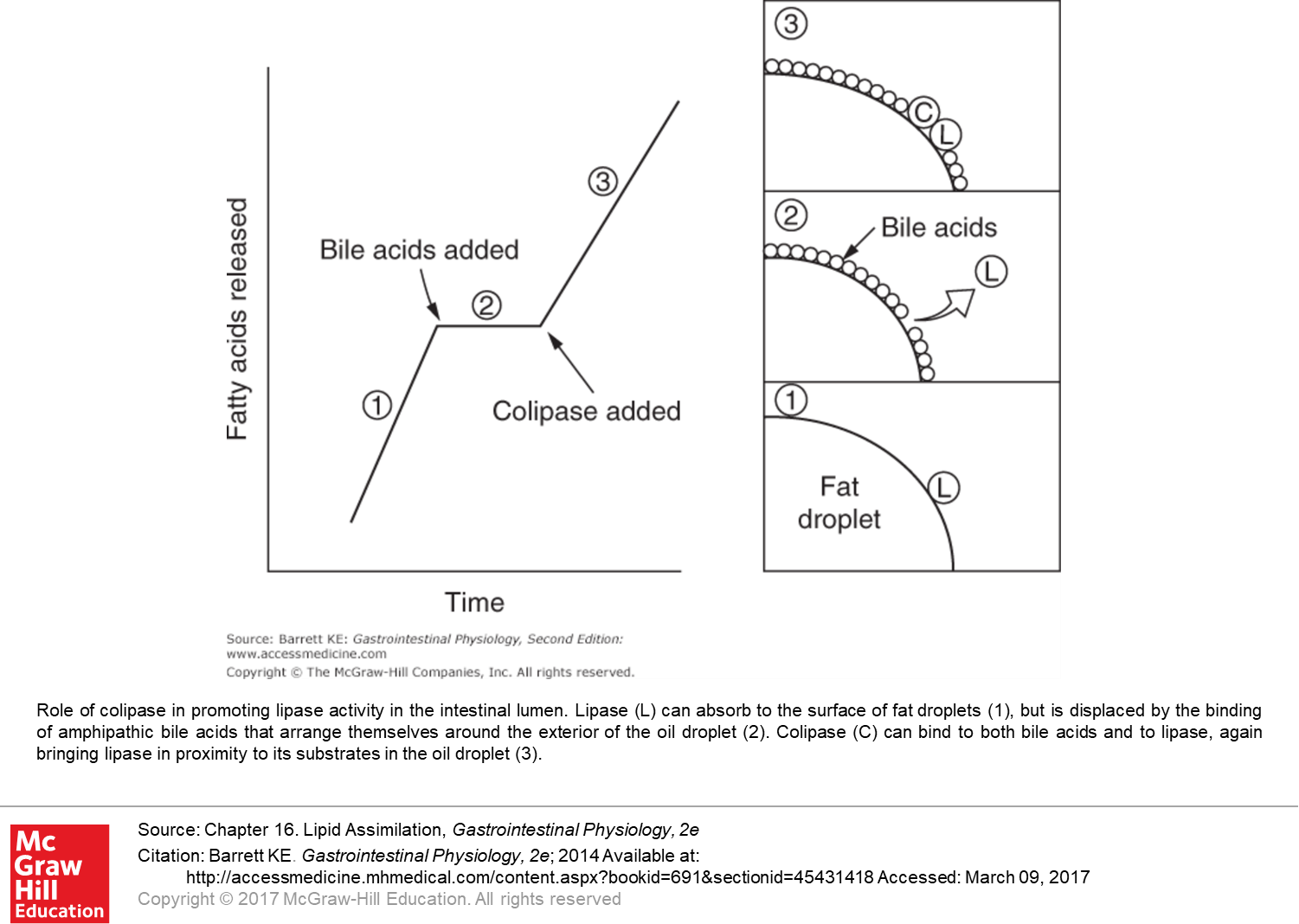
1) Lipid digestion and emulsification begins in the mouth and stomach
→ chewing or mastication also breaks down the fats as well as lingual lipase but this is a minor contribution
→ in the stomach, the grinding action of the stomach and gastric lipase will be the main step of emulsification where we break apart the lipids from the food
2) phospholipids will stabilize the emulsion of fat droplets in the stomach, which will then be deposited into the duodenum
2) In the duodenum, fat droplets bind pancreatic lipases and bile salts
→ the lipase will bind first and then the addition of bile salts will knock off lipase stopping digestion, as seen above
→ colipase will stabilize the interactions of bile salts with lipase allowing for digestion to continue
What is a Micelle? (draw it out)
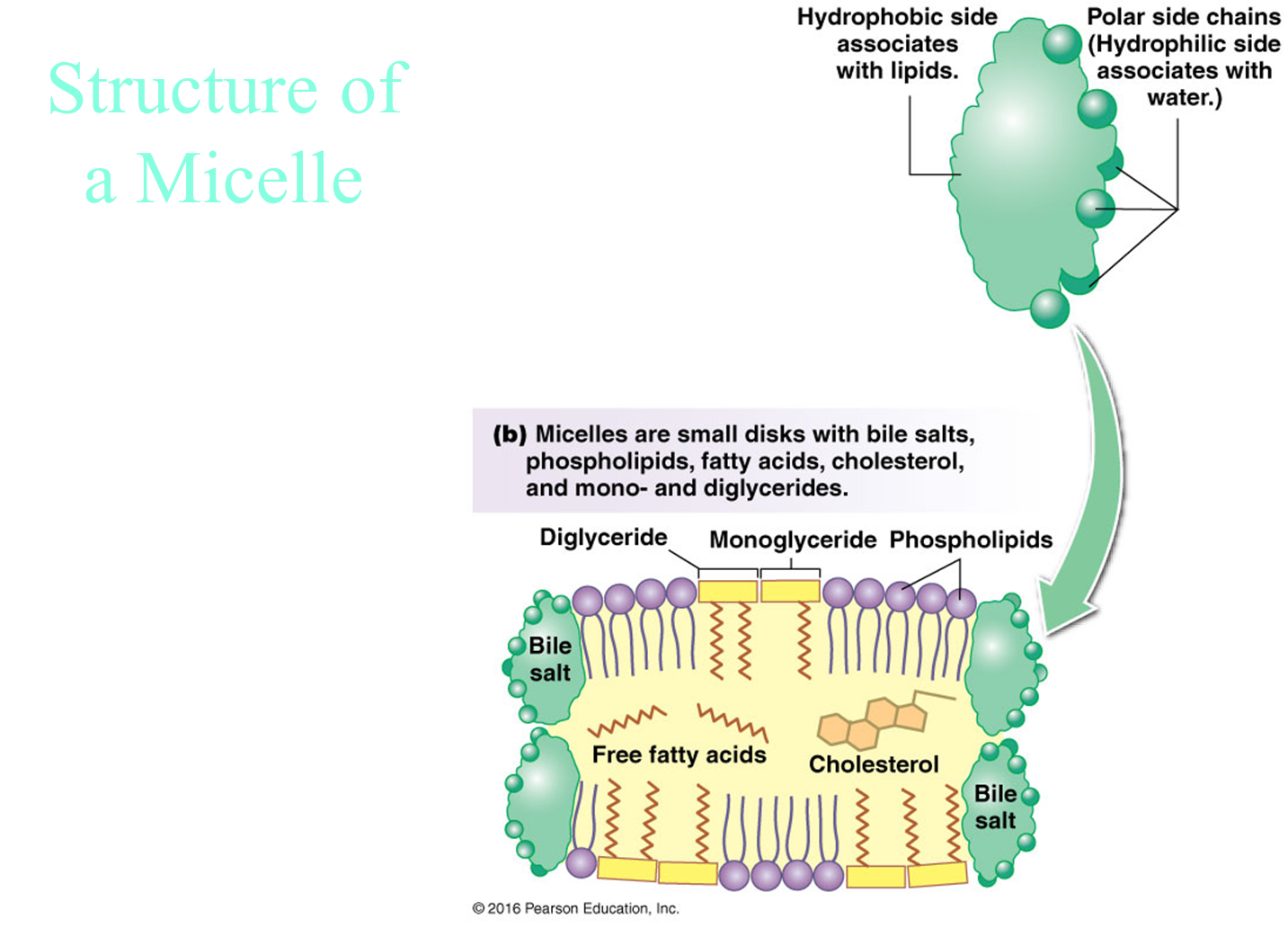
Micelles are small discs with bile salts, phospholipids, fatty acids, diglycerides, and monoglycerides. These randomly assemble in this form and will be carried around the gut in this way.
→ micelles will “hide” the fat by being sequestered inside the micelles
How are lipids absorbed by the enterocytes?
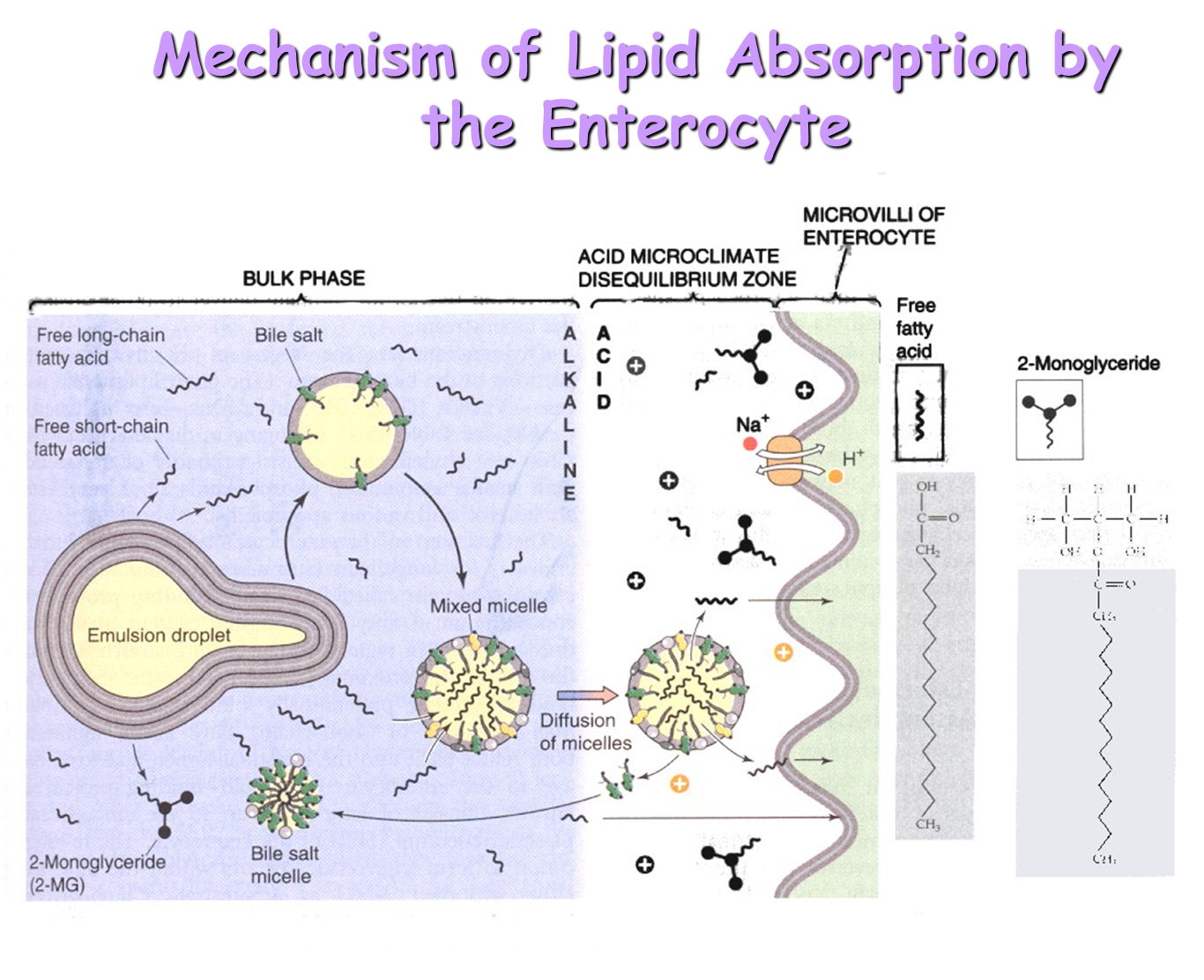
Following formation of a mixed micelle a few things happen:
1) Micelles will cross from the alkaline area of the duodenum to the acidic area of the apical membrane of the enterocyte
→ this will charge and kick out the fatty acids from the micelle
2) the free fatty acids will be taken up by the enterocytes in some mysterious way
→ the micelle will continue giving up free fatty acids first and then lastly cholesterol at the ileum
→ as it gives up its cholesterol, the micelle will fall apart allowing the bile salts to be recycled
What happens to free fatty acids in the enterocyte
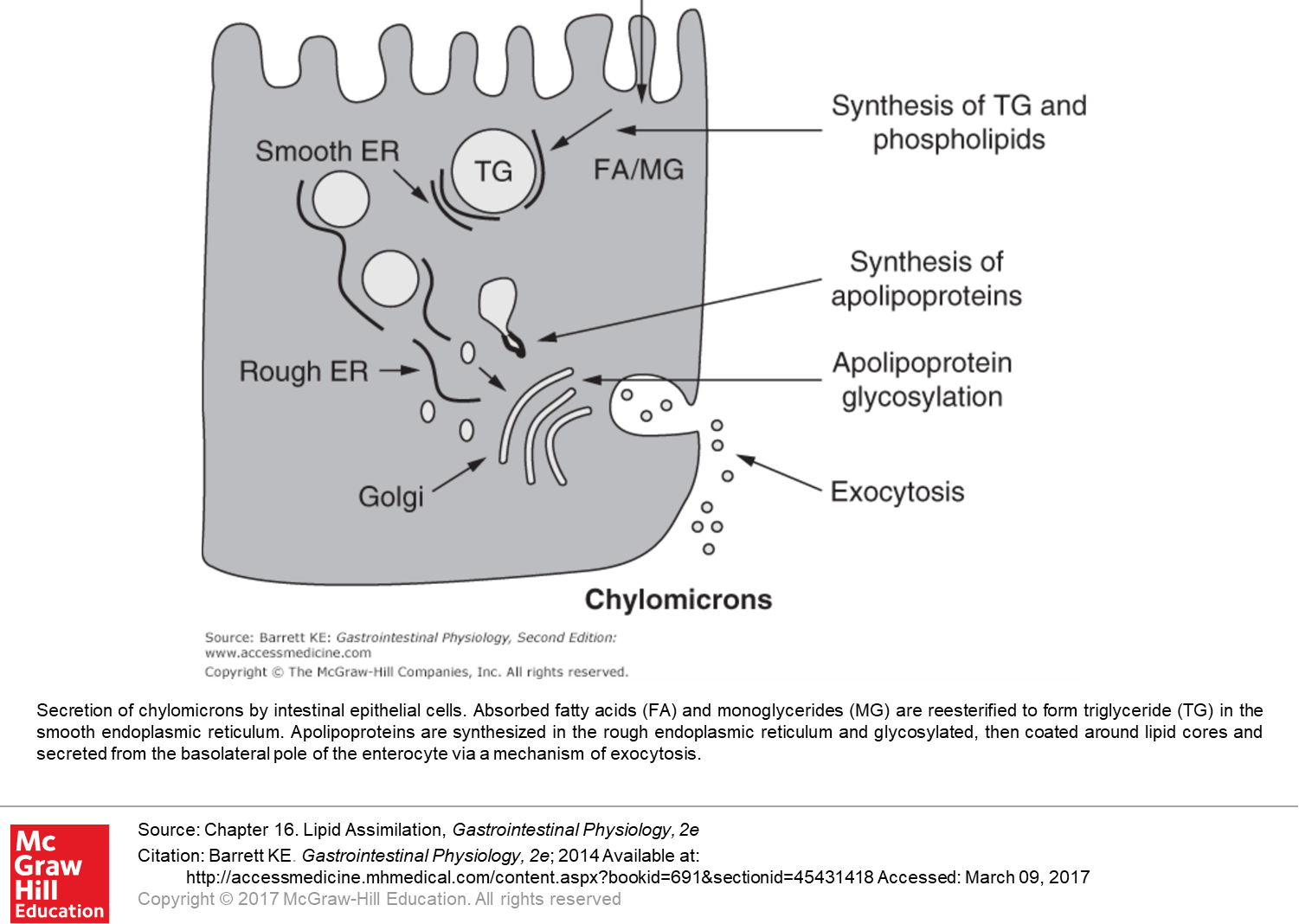
Free fatty acids and monoglycerides are taken up by enterocytes into the smooth ER
→ here they are packaged again into triglycerides which will be packaged into chylomicrons with apolipoproteins at the golgi apparatus
→ chylomicrons are too large to enter the capillaries so they are exocytosed into the lacteals and enter the lymph vessels
What happens to chylomicrons in the lymphatic system

Chylomicrons in lymphatics will be dumped off at the left thoracic duct where they will enter systemic circulation
→ the chylomicrons will circulate through the blood and periodically bump into the walls of the vessels
→ the walls of the endothelial cell vessels will have a lipase that will break down fats in the chylomicrons
→ when chylomicrons have no fat left, they become remnant chylomicrons and are cycled back to the liver where they get refilled with cholesterol and become LDL
Where does most fat digestion and absorption take place
Most fat digestion will be finished by the jejunum while most of the absorption occurs in the jejunum and ileum
Where does most of the fluid get absorbed in the GI tract

most of the absorption of water occurs in the small intestine
→ this occurs because of the absorption of salts that occurs here
→ the remaining amount of water will be in the colon
What is the pathway water reabsorption
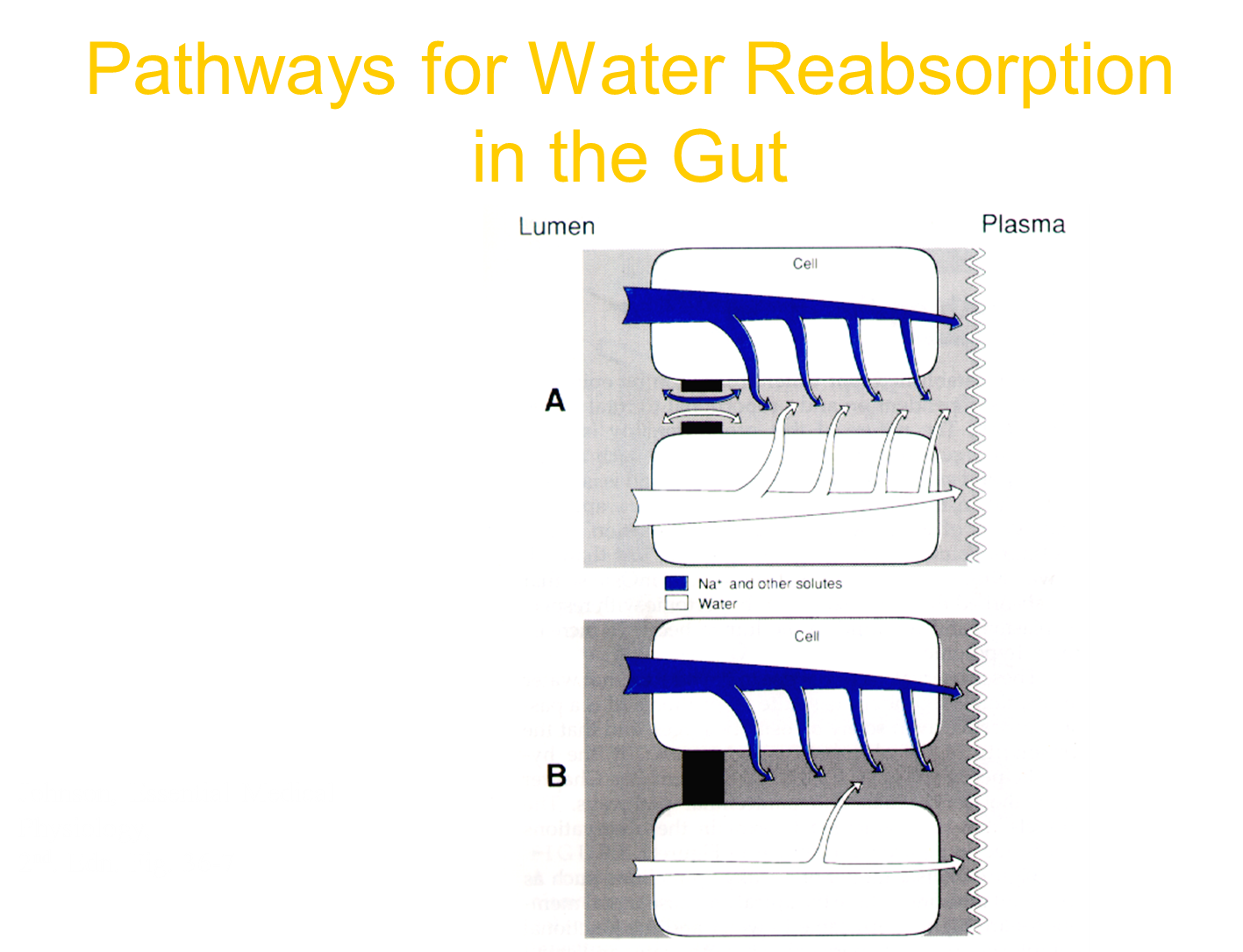
Paracellularly through the tight junctions between the enterocytes
→ this epithelium could be considered leaky